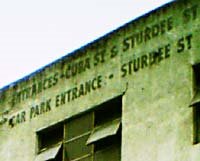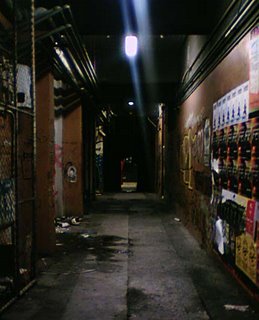Walls without a museum
There was a recent article in the London Review of Books that got me thinking. Peter Calder discussed Callum Storie's book The Delirious Museum, which advocates that the museum should become "both a repository of the artefacts of the past and a continuation of the city street in the present", and moved on to a meditation on Paris street signs and what they reveal about the vanished history of the city.
 While Wellington doesn't have same depth and violence of history in its streets (like the French Revolution's erasure of street names derived from saints), you can still find reminders of whole streets that disappeared. This sign on the Dixon St side of the old Farmers building refers to Sturdee St, which after much demolition in the 1970s was absorbed into the traffic-clogged artery that is now Victoria St.
While Wellington doesn't have same depth and violence of history in its streets (like the French Revolution's erasure of street names derived from saints), you can still find reminders of whole streets that disappeared. This sign on the Dixon St side of the old Farmers building refers to Sturdee St, which after much demolition in the 1970s was absorbed into the traffic-clogged artery that is now Victoria St. But it's the concept of the museum as "continuation of the city street" that intrigued me, and I thought of ways of reversing the proposition. What about the street as museum? The Paris street signs are an example of this, whereby the informed stroller can read the city's history through the "signs" (literal or otherwise) on the street. And I can think of at least one part of the Wellington streetscape that has become a de facto art gallery: this grungy alley between Ghuznee St and the Left Bank has become an ever-changing collection of street art that fascinates braver passers-by. This ZoomIn page shows its location and several photos, and I've also posted these photos on Flickr.
But it's the concept of the museum as "continuation of the city street" that intrigued me, and I thought of ways of reversing the proposition. What about the street as museum? The Paris street signs are an example of this, whereby the informed stroller can read the city's history through the "signs" (literal or otherwise) on the street. And I can think of at least one part of the Wellington streetscape that has become a de facto art gallery: this grungy alley between Ghuznee St and the Left Bank has become an ever-changing collection of street art that fascinates braver passers-by. This ZoomIn page shows its location and several photos, and I've also posted these photos on Flickr.Apart from the usual mindless tags, there's a mix of political and artistic expression, but disappointingly few examples that combine the two. The political graffiti tends to be urgent but artless; and the prettier cutouts and stencils seem more like the work of design students pitching for a lucrative illustration contract. I've yet to see much to rival the subversive talent of someone like Banksy, so perhaps this is another example of Wellington's creeping complacency.
The key to seeing the street as a museum is the phrase I used above: "the informed stroller". To become your own curator of the street, you either need a personal understanding of the city or a good guide. That, perhaps, is where "Web 2.0" technologies like blogs, Wikipedia, Flickr and ZoomIn can come into play, by allowing people to "edit" the city and share their selections with others. The city as it is, with its wealth of easy-to-miss details and stories, could be seen as an inversion of the "Museum without Walls", André Malraux's descriptions of books that took art to the people rather than being confined within a physical institution. The city consists of "Walls without a Museum", but when people share their selections it can become a superposition of thousands of museums: artistic, historical, architectural, frivolous or subversive. Beyond their practical mapping applications, this is an exciting possibility for Google Maps mashups and ZoomIn Groups.


1 Comments:
Damn I love this Blog. Tom you do a great job. The idea of the city as a wall-less museum is not a new one but a very good one. It is always good to read your musiings on these topics and I look forward to reading almost everyday.
Cheers Tom... Loving it.
Post a Comment
<< Home